Cervixes
They're kind of amazing. Yours will tell you what you need to know.
Every woman’s cycle is unique. You can use the information on this page and throughout the WHWH website to understand what’s happening during your cycle as you learn whether your cervix changes vary from cycle to cycle or if you have a consistent pattern. You’ll notice how to recognize your fertility onset and how it matches up with the way your cervix looks and feels. Try to check your cervix the same time of day, each day.
The number of days from the beginning of your period to ovulation vary between women and often can vary from cycle to cycle for the same woman.
What’s important is understanding your unique body.
Variations Of Normal Healthy Cervixes
Cervixes are similar...and unique
This presentation shows you the normal variations for cervixes. You’ll see two conditions; one called nabothian cysts and one called eversion (also called ectropion)– these might confuse you or worry you but they're both very common and not health threatening.
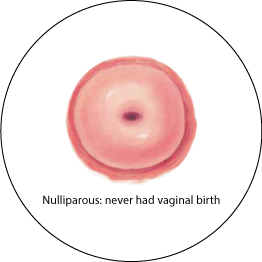
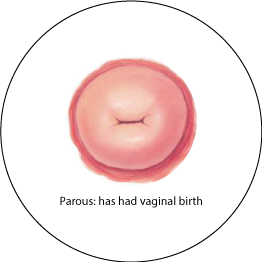
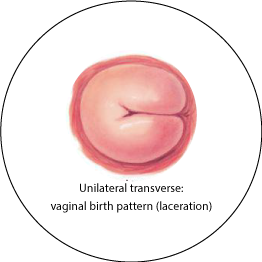
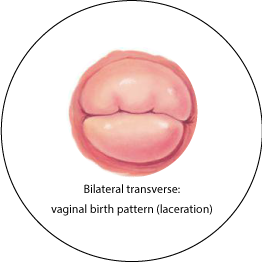
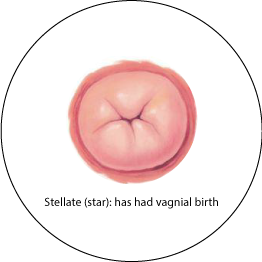
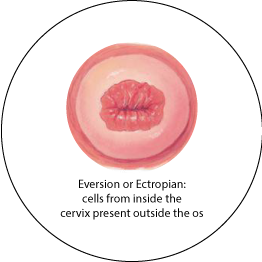
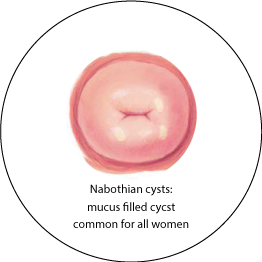
Cervical os is round
A woman who never had a vaginal birth.
Cervix of a female who's never given birth through the vaginal canal. (Nulliparous)
Cervix of a female who has given birth through the vaginal canal.
Cervix of a female who has given birth through the vaginal canal. (Parous)
A variation of a completely normal cervix after vaginal birth. (Unilateral transverse)
A variation of a completely normal cervix after vaginal birth. (Unilateral transverse)
A variation of a completely normal cervix after birth through the vaginal canal.
A variation of a completely normal cervix after birth through the vaginal canal.
A variation of a completely normal cervix after birth through the vaginal canal. (Stellate)
Squamo-columnar junction: the rim where lining of the cervical canal meets the face of the cervix. This forms a visible red circle around the os. (see details below this presentation).
Squamo-columnar junction: the rim where lining of the cervical canal meets the face of the cervix. This forms a visible red circle around the os. (see details below this presentation).
Cysts : considered normal cervical anatomy and form when normal tissue on the cervix grows over mucus-producing tissue, traps the fluid or tissue and a cyst forms.
What you see here are cysts which are benign and common. Cysts are considered normal cervical anatomy and form when normal tissue on the cervix grows over mucus-producing tissue, traps the fluid or tissue and a cyst forms.
Nabothian cysts are considered normal cervical anatomy and form when normal tissue on the cervix grows over mucus-producing tissue, traps the fluid or tissue and a cyst forms.
Eversion is non cancerous and happens when normal (columnar) cells from the cervical canal present on the outside (squamous) of the cervix. The cells might look red or raw and can be covered with yellow discharge. Unfortunately you might hear the word erosion used with this situation. Your cervix is not eroding with eversion. The only time treatment is advised for eversion is when women experience excessive discharge or spotting (which is very rare) because treatment is invasive and might create worse discharge.
Your Cervix During Your Cycle
Cervixes are similar...and unique
Most of the information on this page will help you with FAM (Fertility Awareness Method of birth control) and managing your fertility.
Typically while you’re menstruating your cervix will be firm, and your cervical os will be open since blood is flowing. After menstruation, your cervical os will be closed. Your cervix might feel like it’s angled to one side or the other (which is common).
When you’re ovulating, estrogen increases and your cervix might be higher inside your vagina because your ligaments will tighten. Your cervix might feel softer. When estrogen decreases after ovulation your cervix will be easier to feel and will be more firm with your cervical os closed.
Below are two links from The Beautiful Cervix Project that show you examples of a 25 yo woman with a 33 day cycle and a 30 yo woman with a 24-25 day cycle.
Your Pregnant Cervix
Your pregnant cervix, or in this case (also from The Beautiful Cervix Project)
an example of a 30 year old woman’s cervix pre pregnancy, pregnancy and postpartum.
*the image above is from a different pregnant woman, and shows you her cervix is Ectropion (see the presentation above for a description of the non threatening Ectropion cervix cells).
Your Post Menopausal Cervix
Our bodies are amazing. These three post menopausal examples of women’s cervixes are from The Beautiful Cervix Project.
The first example is of a 57 yo woman who saw her cervix for the first time during a self help group workshop. You can read the rest of her great story on The Beautiful Cervix Project website.
The next two examples are of a 62 yo sexually active post menopausal woman and a photo of a 53 year old post menopausal woman.

